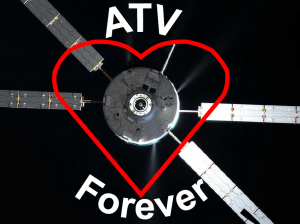Greetings, ATV!
Time for farewells!! The Dragon spacecraft left the International Space Station earlier this week and today ESA’s ATV spaceship with the catchy name Georges Lemaître detached from the Station and will plunge after several orbits into Earth’s atmosphere. Due to the enormous heat from friction caused by its deceleration through the upper layers of air layers the spacecraft will turn into a huge fireball – a fitting end to the spacecraft that is named after one of the founding fathers of the Big Bang theory!
Unfortunately, this will be the last ATV – after five very successful missions, the project is now complete. At the Columbus Control Center (Col-CC) we provided for each flight the ground infrastructure and supplied our colleagues at ATV Control Centre in Toulouse, France, with data, video and voice connections to the International Space Station network. After ESA astronaut Samantha Cristoforetti and cosmonaut Alexander Samokutyaev closed the hatches of ATV yesterday, the Space Station was prepared for the last hours of undocking of ATVs. We turned off our little amateur radio station [https://www.ariss.org/] in Columbus as well as the external Rapidscat experiment [https://www.jpl.nasa.gov/missions/iss-rapidscat/], any radio interference with ATV’s navigation from the International Space Station should be avoided.Slowly the Space Station turned to an appropriate orientation for undocking. When the moment arrived the Space Station’s active position control was turned off completely: Georges Lemaître needs to push away from the Space Station without the mothership trying to compensate for this force.
Afterwards all that remained was for the astronauts to wave good-bye …
 ATVs are part of a large space fleet that supplies the International Space Station. When the American Space Shuttle withdrew from service the Russian Soyuz spacecraft became the only way to get people to the Space Station and back on Earth. Three astronauts share a small space – and so there is little room for other supplies.
ATVs are part of a large space fleet that supplies the International Space Station. When the American Space Shuttle withdrew from service the Russian Soyuz spacecraft became the only way to get people to the Space Station and back on Earth. Three astronauts share a small space – and so there is little room for other supplies.
Tom Uhlig, Columbus Flight Director at the DLR center in Oberpfaffenhofen/Germany
Cover image by ESA astronaut Samantha Cristoforetti: https://www.flickr.com/photos/astrosamantha/16546104212/ .
16/02/2015




